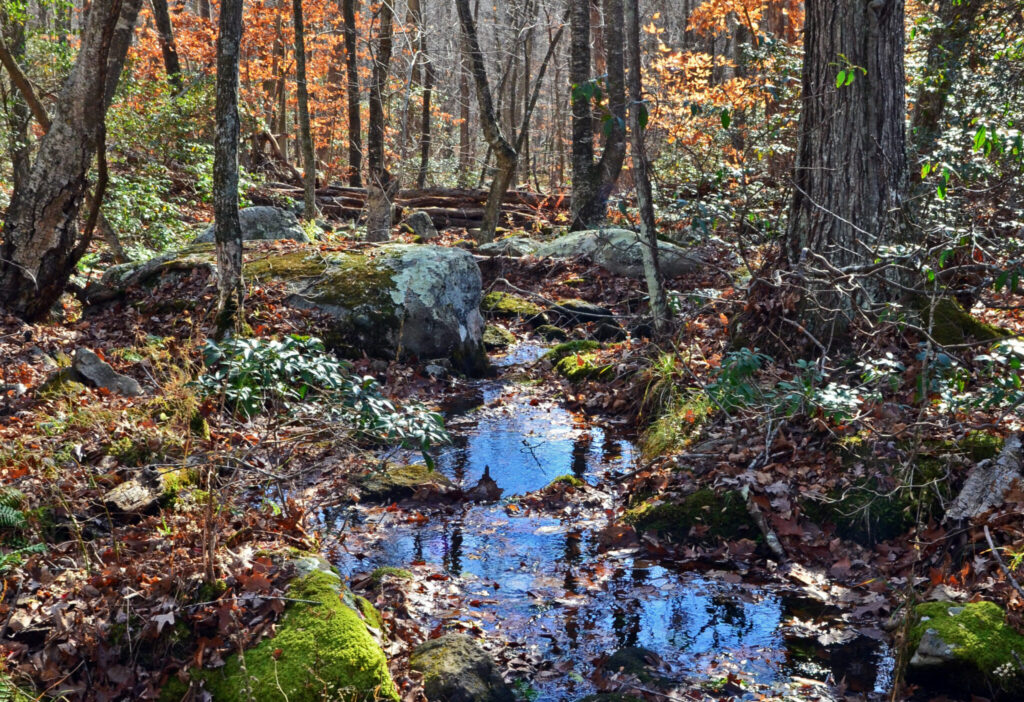Community Rallies Behind Conservation Effort to Protect Forestland and Water Quality
 East Lyme, CT (January 6, 2017)—With financial support from Town of East Lyme, the State of Connecticut, and numerous private supporters, New England Forestry Foundation (NEFF) has conserved 166 acres of critical habitat at the Headwaters of the Niantic River in East Lyme, Connecticut. This success marks the first phase of a significant conservation effort which will lead to the permanent protection of and community access to at least 200 acres of productive forestland.
East Lyme, CT (January 6, 2017)—With financial support from Town of East Lyme, the State of Connecticut, and numerous private supporters, New England Forestry Foundation (NEFF) has conserved 166 acres of critical habitat at the Headwaters of the Niantic River in East Lyme, Connecticut. This success marks the first phase of a significant conservation effort which will lead to the permanent protection of and community access to at least 200 acres of productive forestland.
Home to diverse wildlife, plant communities, wetland resources, and topography, the Headwaters of the Niantic River is part of a larger 2,200-acre forest block in East Lyme and Waterford. This significant area of forested corridor is comprised of approximately twenty parcels, mostly privately owned. The Headwaters of the Niantic River protects nearly one tenth of this forested habitat.
The project is part of a larger movement to protect the health of the Niantic River estuary, which is central to the town’s history and identity. East Lyme’s town symbol, the bay scallop shell, reflects the town’s proud shell-fishing roots. Today, the impaired health of the Niantic River estuary threatens the local shell-fishing industry. This conservation success will ensure that water flowing from a portion of the headwaters will continue to be filtered by the forest and natural wetland habitat, helping maintain water quality in the estuary.
Conserving the Headwaters of the Niantic River is consistent with the State of Connecticut Green Plan, the plans of Conservation and Development of Southeastern Connecticut Council of Governments (SCOOG), and the town of East Lyme. The conservation project received letters of support from The Niantic River Watershed Committee, and East Lyme’s Board of Selectmen, Commission for the Conservation of Natural Resources, and Inland Wetlands Agency and Planning Commission.
Grassroots support for the project originated from an unexpected place—the previous property owner and local developer, Steve Harney. Harney provided a discounted sale price and was extremely helpful to efforts to rally town, state DEEP, and United States Forest Service support for the project, ensuring that the project was a success. Private support came from the Geoffrey C. Hughes Foundation, Bafflin Foundation, Ruth Lord Charitable Trust, Summer Hill Foundation, the Community Foundation of Eastern Connecticut, the Fields Pond Foundation, and the Sasco Foundation. Several local families and individuals also contributed to the $1.7 million campaign to conserve the 200 acre property.

With more than 26,000 acres conserved throughout New England, the Headwaters of the Niantic River marks NEFF’s third Community Forest in Connecticut.
“We are thrilled to expand our work in the state of Connecticut, and humbled by the outpouring of private and public support for the Headwaters of the Niantic River project,” stated Robert Perschel, NEFF’s Executive Director. “We also are excited about the project’s 34-acre Phase 2, and look forward to working with the local community to ensure this woodland remains a productive and valuable resource for generations to come.”
Phase 2 of the project has been awarded DEEP Open Space Grant funds, a grant from the US Forest Service’s Community Forest program, and support from the Geoffrey C. Hughes Foundation. Additional public and private contributions will be needed to ensure Phase 2 is a success. To contribute to the Headwaters project, please visit our online donation page.
On all of its community forests, NEFF practices exemplary, sustainable forestry while providing opportunities for public recreation. “Exemplary forest management delivers a stream of useful products to society while simultaneously maintaining forest health, improving habitats and recreational opportunities, and encouraging the regeneration of new trees,” explains Whitney Beals, NEFF’s Director of Land Protection. “Under NEFF’s stewardship, the Headwaters of the Niantic River will continue to provide all the benefits of a working forest, and it also will serve as a valuable recreational and environmental resource with a network of walking trails for the local community.”

